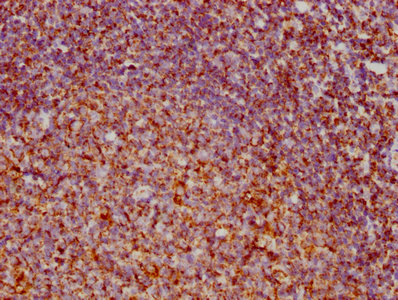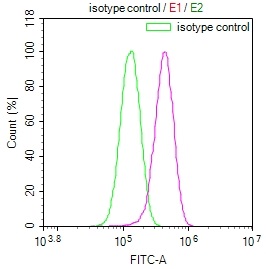POLK Antibody
-
货号:CSB-PA018317GA01HU
-
规格:¥3,900
-
其他:
产品详情
-
Uniprot No.:Q9UBT6
-
基因名:POLK
-
别名:DinB homolog 1 (E. coli) antibody; DINB protein antibody; DINB1 antibody; DINP antibody; DNA damage inducible protein b antibody; DNA polymerase kappa antibody; Polk antibody; POLK_HUMAN antibody; POLQ antibody; Polymerase (DNA directed) kappa antibody; polymerase, DNA, kappa antibody
-
宿主:Rabbit
-
反应种属:Human,Mouse,Rat
-
免疫原:Human POLK
-
免疫原种属:Homo sapiens (Human)
-
抗体亚型:IgG
-
纯化方式:Antigen Affinity purified
-
浓度:It differs from different batches. Please contact us to confirm it.
-
保存缓冲液:PBS with 0.1% Sodium Azide, 50% Glycerol, pH 7.3. -20°C, Avoid freeze / thaw cycles.
-
产品提供形式:Liquid
-
应用范围:ELISA,WB,IHC
-
Protocols:
-
储存条件:Upon receipt, store at -20°C or -80°C. Avoid repeated freeze.
-
货期:Basically, we can dispatch the products out in 1-3 working days after receiving your orders. Delivery time maybe differs from different purchasing way or location, please kindly consult your local distributors for specific delivery time.
相关产品
靶点详情
-
功能:DNA polymerase specifically involved in DNA repair. Plays an important role in translesion synthesis, where the normal high-fidelity DNA polymerases cannot proceed and DNA synthesis stalls. Depending on the context, it inserts the correct base, but causes frequent base transitions, transversions and frameshifts. Lacks 3'-5' proofreading exonuclease activity. Forms a Schiff base with 5'-deoxyribose phosphate at abasic sites, but does not have lyase activity.
-
基因功能参考文献:
- This study found that human DNA Polymerase kappa is more tolerant to changes in the active site loop than E. coli DinB. [DinB] PMID: 28823149
- Two X-ray crystal structures of POLK provide mechanistic insights into the error-free lucidin-N(2)-dG DNA adduct bypass catalyzed by POLK. PMID: 28972744
- POLH & POLK are both able to exchange with PolD1 stalled at repetitive CFS (common fragile sites) sequences. POLD1 synthesis was inhibited by replication stress caused by aphidicolin, preventing any replication past CFS. Importantly, POLH & POLK were still proficient in rescuing this stalled POLD1 synthesis. POLD1 stalling at CFSs allows for free exchange with specialized polymerase that is not driven by PCNA. PMID: 28605669
- The structure of polK captured at the lesion-extension stage is reported: the enzyme is extending the primer strand after the base pair containing the BP-dG adduct in the template strand at the -1 position. PolK accommodates the BP adduct in the nascent DNA's minor groove and keeps the adducted DNA helix in a B-form. PMID: 27894903
- A report on the structure of human polkappa in complex with a major benzo[a]pyrene adduct reveal a unique mechanism for accurate replication by translesion synthesis past the major bulky adduct. PMID: 27034468
- These studies revealed that POLK is a crucial host factor required for covalently closed circular DNA formation during a de novo HBV infection PMID: 27783675
- DNA polymerases eta and kappa are capable of bypassing of a bulky guanine lesion during DNA replication. PMID: 27612622
- POLK protein polymorphisms may influence the risk of developing breast cancer among Chinese women. PMID: 26765445
- Somatic Mutations in Catalytic Core of POLK Reported in Prostate Cancer Alter Translesion DNA Synthesis PMID: 26046662
- POLK not only protects cells from genotoxic DNA lesions via DNA polymerase activities, but also contributes to genome integrity by acting as a non-catalytic protein against oxidative damage caused by hydrogen peroxide and menadione. PMID: 26031400
- The steric gate is crucial for rNTP discrimination because of its role in specifically promoting a dNTP-induced conformational change and that rNTP discrimination occurs in a relatively closed state of the polymerases. PMID: 25684709
- The structural dynamics of DinB1 changes upon substrate binding, noncognate DNA damage prevents the formation of the active conformation of DINB1. PMID: 25899385
- polymorphism of POLK, an important gene in TLS, participates in platinum-chemotherapy tolerance and side-effect PMID: 24948471
- The study shows that the Werner syndrome protein stimulates the 8-oxo-dG bypass activity of hpol kappa in vitro by enhancing the correct base insertion opposite the lesion, as well as extension from dC:8-oxo-dG base pairs. PMID: 25294835
- Mutations in PIP1 domain inhibits the stimulation of DNA synthesis by Polkappa in the presence of proliferating cell nuclear antigen, replication factor C, and replication protein A; and mutations in PIP2 have no effect on PCNA-dependent DNA synthesis. PMID: 24848457
- The truncation R219X was devoid of polymerase activity, and the E419G and Y432S variants showed much lower polymerase activity than wild-type POLK. PMID: 24725253
- A slow conformational change after the nucleotidyl transfer is the rate-limiting step for hpol kappa catalysis. PMID: 25065501
- role of the unique Polkappa gap and N-clasp structural features in the fidelity of minor groove lesion processing with extensive molecular modeling and molecular dynamics simulations to pinpoint their functioning in lesion bypass PMID: 25148552
- Phenylalanine 171 is used by PolK as a molecular brake for translesional synthesis across benzo[a]pyrene DNA adducts. PMID: 24461735
- The molecular mechanism of 3-nitrobenzanthrone genotoxicity in HEK293 cells is reported. PMID: 25080294
- DNA polymerase kappa rs5744724 polymorphism is associated with lung cancer. PMID: 24012694
- Pol eta and Pol kappa are involved in redundant pathways for homologous recombination. PMID: 23731732
- DNA polymerase kappa-dependent DNA synthesis at stalled replication forks is important for CHK1 activation. PMID: 23799366
- The results show that hPolkappa uses a classical Streisinger template-slippage mechanism to generate -1 deletions in repetitive sequences. PMID: 23558743
- Data indicate that small molecule library screens targeting DNA polymerase kappa would initiate the development of new adjunct cancer therapeutics. PMID: 23056190
- Molecular dynamics simulations show that the near error-free incorporation of dCTP opposite the major benzo[a]pyrene-derived dG lesion is compatible with the Water Mediated and Substrate Assisted (WMSA) mechanism, allowing for an essentially undisturbed pentacovalent phosphorane transition state, and explaining the bypass of this lesion with little mutation by Pol kappa. PMID: 22772988
- Data suggest that DNA polymerase kappa (pol kappa) partially protects cells from the mismatch repair (MMR)-dependent cytotoxicity. PMID: 22487424
- The expression of Pol kappa (and Pol iota) is deregulated in gliomas, and upregulation of Pol kappa is associated with poorer prognosis in glioma patients. PMID: 20164241
- transcriptional activities of the POLK promoter regions -336/+437 and +20/+437 were significantly reduced by BPDE treatment, indicating that transcription factors in these regions may regulate the transcription of human POLK gene in response to BPDE. PMID: 22227292
- show that the loss of USP1 leads to a dramatic reduction of replication fork speed in a Polkappa-dependent manner PMID: 22157819
- the substitution of alanine for phenylalanine 171 (F171), an amino acid conserved between Pol kappa and its bacterial counterpart Escherichia coli DinB, enhanced the efficiencies of dCMP incorporation opposite (-)- and (+)-trans-anti-BPDE-N(2)-dG 18-fold PMID: 21078407
- Data show that showed that pol kappaDeltaC was more efficient than pol eta by incorporating dCMP opposite both 6alpha- and 6beta-isomeric dG-N(2)-6-E(2) adducts. PMID: 18512958
- results suggested that amino acids at distinct positions in the active sites of Poleta and Polkappa might enhance 8-oxo-dGTP to favor the syn conformation, and thus direct its misincorporation into DNA. PMID: 19939936
- a role of Pol(kappa) in the extension of mismatched base pairs during normal DNA replication, and in addition, they implicate Pol(kappa) in the mutagenic bypass of T-T dimers PMID: 11842189
- Translesion synthesis by human DNA polymerase kappa on a DNA template containing a single stereoisomer of dG-(+)- or dG-(-)-anti-N(2)-BPDE. PMID: 11994005
- In DNA damage, this protein bypasses and extends beyond thymine glycols during DNA synthesis in vitro, preferentially incorporating correct nucleotides PMID: 12145297
- Polkappa may function as part of the replication machinery itself and could be recruited when replicative complexes are stalled; may affect the accuracy of DNA replication PMID: 12414988
- Opposite an 8-oxoguanine (8-oxoG) lesion, Polkappa efficiently inserts an A & then proficiently extends from it. Also, Polkappa can perform the extension step after the incorporation of nucleotides opposite these lesion sites by Poldelta. PMID: 12444249
- Data suggest that the properties of DNA polymerases eta and kappa are consistent with the mutagenic events attributed to estrogen-derived DNA adducts. PMID: 15147214
- POLK interacts with a C-terminal region of REV1. PMID: 15189446
- POLK does not colocalize in replication foci with PCNA. PMID: 15601657
- the trans-lesion synthesis enzyme polkappa is specifically required for normal recovery from the BPDE-induced S-phase checkpoint PMID: 15817457
- POLK causes error-prone and inefficient replication across 8-oxoguanine in ras genes. PMID: 15938713
- DNA polymerase kappa (Pol kappa) is a specialised low-fidelity DNA polymerase. It is able to perform DNA synthesis across several damaged bases. But when it is misregulated, it will increase genetic instability. PMID: 15989980
- both Poleta and Polkappa rely on W-C hydrogen bonding for localizing the nascent base pair in the active site for the polymerization reaction to occur PMID: 16055723
- Association of Polkappa with PCNA is regulated by Rad18-mediated PCNA ubiquitination. PMID: 16611994
- pol kappa is resistant to N(2)-bulk and quantitatively efficient in catalyzing dCTP incorporation opposite bulky guanine N(2)-adducts, particularly the largest (N(2)-BPG) PMID: 16751196
- promoter of POLK is cis-controlled PMID: 17099721
- DNA encirclement and other structural features help explain Pol kappa's ability to extend mismatches and to promote replication through various minor groove DNA lesions. PMID: 17317631
- Human DNA polymerase kappa inserts dGMP and dCMP within the [T](11) mononucleotide repeat, producing an interrupted 12-bp allele. PMID: 18079151
显示更多
收起更多
-
亚细胞定位:Nucleus.
-
蛋白家族:DNA polymerase type-Y family
-
组织特异性:Detected at low levels in testis, spleen, prostate and ovary. Detected at very low levels in kidney, colon, brain, heart, liver, lung, placenta, pancreas and peripheral blood leukocytes.
-
数据库链接:
HGNC: 9183
OMIM: 605650
KEGG: hsa:51426
STRING: 9606.ENSP00000241436
UniGene: Hs.135756
Most popular with customers
-
-
YWHAB Recombinant Monoclonal Antibody
Applications: ELISA, WB, IF, FC
Species Reactivity: Human, Mouse, Rat
-
Phospho-YAP1 (S127) Recombinant Monoclonal Antibody
Applications: ELISA, WB, IHC
Species Reactivity: Human
-
-
-
-
VDAC1 Recombinant Monoclonal Antibody
Applications: ELISA, WB, IHC
Species Reactivity: Human, Mouse, Rat
-




















